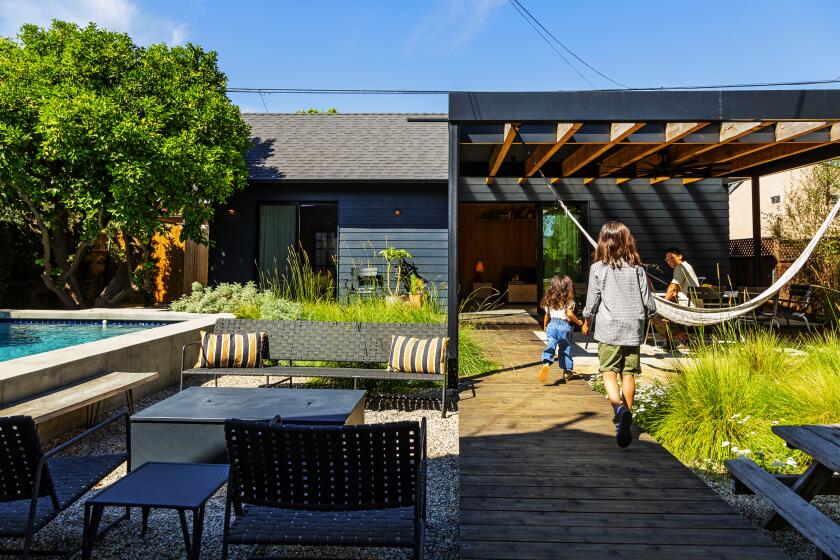Northridge Ranch Latest to Join the Historic Site Casualty List : Damage: Three of six buildings at the 200-year-old Rancho Cordillero del Norte fall in shambles.
- Share via
It’s an idyllic slice of early California, all but gobbled up by Northridge’s suburban growth and suddenly crippled by Mother Nature.
Rancho Cordillero del Norte (Ranch of the North Ridge)--once a sheep farm on the sprawling old Mission San Fernando some 200 -years ago--is another casualty of the Northridge earthquake, which has temporarily closed several other historic sites in the San Fernando and Santa Clarita valleys.
Three of Rancho Cordillero’s six buildings, obscured from motorists by trees at Nordhoff Street and Wilbur Avenue, fell in shambles. The others--battered but restorable--show scars and bruises worthy of their proximity to the epicenter of the 6.6-magnitude quake.
A circular tower made of river rock on this eight-acre estate collapsed in a heap, leaving the house alongside it (circa 1917) condemned. At a stone hut believed to be a former stagecoach stop, the tile roof caved in.
And a wooden porch and its shake roof ripped loose from a studio used by the property’s owner-occupant Elisabeth Waldo, who composes, plays violin and teaches ethnic music here as founder-director of the nonprofit Multicultural Music and Art Foundation of Northridge.
“No way this stops us!” Waldo said as reconstruction began on land where she and her husband, the late Carl Dentzel, a Valley pioneer who helped name the community Northridge, settled as newlyweds in 1950.
“It’s the spirit of what you do that keeps you going,” said Waldo, who conducts concerts and workshops in Native American, Spanish and Asian music at the estate. “It’s inconvenient living here now, but it doesn’t throw me.”
Rancho Cordillero, where Waldo hopes to resume cultural events in March, joins three more of the San Fernando Valley’s oldest buildings waylaid by the quake: the Andres Pico Adobe (1834) in Mission Hills, the Leonis Adobe (1844) in Calabasas and the Lopez Adobe (1882) in San Fernando.
Actually, the Pico Adobe--it was originally owned by Mexican Army Gen. Andres Pico, brother of Pio Pico, California’s last Mexican governor--had closed more than a year ago for earthquake retrofitting. But before work could begin, the Jan. 17 quake tore a gaping hole out of the two-story, Spanish Mission-style house, cracked walls and sheared off the chimney and parts of a courtyard adobe wall.
Now, the adobe will stay closed for at least another year, said Bobette Fleschler, president of the San Fernando Valley Historical Society, which occupies temporary quarters on the grounds and will move back into the house when it reopens.
At the Leonis Adobe in Calabasas, the two-story Monterey-style mansion will be closed indefinitely, but other structures on the restored working ranch--the Plummer House, barn and blacksmith shop--will remain open 1 to 4 p.m. Wednesdays through Sundays, said Phyllis Jones, the site’s director.
The Lopez Adobe, believed to be San Fernando’s oldest structure except for the slightly-damaged-but-still-open San Fernando Mission (1797), will be closed to the public indefinitely for repairs to its chimney and walls, said caretaker Bert Weinmann, who resides there.
“I sit and watch the walls now,” he said, “and I wonder if they’re going to fall in.”
Other closings include: the Chatsworth Museum, which may resume tours on Feb. 6; an adobe house museum and a two-story limestone house at Los Encinos State Historical Park in Encino; Glendale’s historic Casa Adobe de San Rafael; and Sylmar’s museum, known as San Sylmar, opened in 1969, home of the Merle Norman Classic Beauty Collection of “functional fine art,” notably antique Rolls-Royce cars and musical instruments.
In the Santa Clarita Valley, the William S. Hart Museum in Newhall has been closed for repairs but officials hope to reopen on Feb. 12. But Hart Park--where the museum sits--and Heritage Junction, the museum-home of the Santa Clarita Valley Historical Society, remain open.
The earthquake destroyed the Mentry House (1893), once the residence of area pioneer Charles A. Mentry, on Pico Canyon Road west of the Golden State Freeway, said local historian Jerry Reynolds. A barn next door survived, he added.
“It’s a major loss because the house was a state historical landmark,” Reynolds said. “Now I guess we’ll have to change it to historical site .”
Times staff writer Julio Moran contributed to this story.
More to Read
Sign up for Essential California
The most important California stories and recommendations in your inbox every morning.
You may occasionally receive promotional content from the Los Angeles Times.










